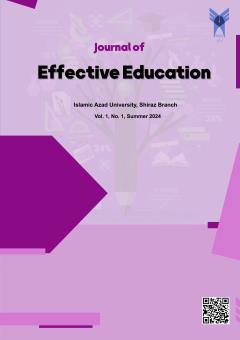Validation of the Social Entrepreneurship Education Model for Secondary School Students in Iraq
Subject Areas : EducationJamal Khasif Hadi 1 * , Hamid Sina 2 , Salam Naji Baqir Al-Ghadban 3 , Nasrollah Ghashghaeizadeh 4
1 -
2 - Department of Educational Sciences, Fa.C. Islamic Azad University, Fasa, Iran
3 - Department of Psychological Counseling and Educational Guidance, Basra Branch, Basra University, Basra, Iraq.
4 - Department of Educational Sciences, Is.C., Islamic Azad University, Isfahan, Iran
Keywords: Entrepreneurship, Social Entrepreneurship, Secondary Education,
Abstract :
Introduction: The main objective of this research was to validate a model for social entrepreneurship education for high school students in Iraq.
Methods: A descriptive correlational method was used. The statistical population for the quantitative section included university professors, managers, and teachers, totaling 351 individuals. A stratified random sampling method was employed. The research instrument was a researcher-made questionnaire derived from the findings of the qualitative phase of the study. Its content validity and reliability were confirmed using Cronbach's alpha, yielding a coefficient of 0.86. To validate the proposed model, the opinions of professors and teachers regarding the questionnaire's format and content were evaluated. Lincoln and Guba's criteria were also utilized. For analyzing the quantitative data, confirmatory factor analysis and structural equation modeling (model fitting) based on partial least squares were used.
Results: The results indicated that the social entrepreneurship education model, which consists of six overarching themes and 15 organizing themes—including goal setting (strategic goals and operational objectives), content foundations (psychological, legal, technological, economic, and health foundations), democratic approach (learner respect, open teaching strategies), culture building (awareness raising, modeling), evaluation (program evaluation, learner assessment), and ecosystem development (identity building, ecosystem enhancement)—has adequate fit. Its validity was confirmed from the perspective of university professors and high school teachers.
Conclusion: This model overall not only covers the technical and skill dimensions of social entrepreneurship but also pays special attention to human and cultural dimensions. Here, social entrepreneurship is seen as a comprehensive activity encompassing both economic and social-environmental aspects. The innovations of this model, compared to similar research, allow it to move beyond traditional frameworks and address the current and future needs of the local and potentially global community.
Abbasi, S., Mirdamadi, S. M., Omidi Najafabadi, M., & Farajallah Hosseini, S. J. (2022). Designing a model for the development of rural ecotourism entrepreneurship with a qualitative approach. Geography and Development, *20*(66), 131–160.https://doi.org/10.22111/gdij.2022.7216
Ahmadi Farsani, A., & Mehran Ali Safari. (2017). Social entrepreneurship: Factors and consequences with the approach of Nahj al-Balagha. Nahj al-Balagha Research Journal, *18*, 99–118.
Derikund, A and Shahriari, J. (2017). Explaining the conceptual model of social entrepreneurship in the Imam Khomeini Relief Committee of the country, Journal of Management and Entrepreneurship Studies, Volume 3, Issue 1.
Gibb, A. A. (1994). Do we really teach (approach) small business the way we should? Journal of Small Business & Entrepreneurship, 11(2), 11-27.
Herring III, H. C., & Williams, J. R. (2000). The role of objectives in curriculum development. Journal of Accounting Education, 18(1), 1-14.
Heidari, Z., Rahimi Eghdam, S., & Hosseini, S. S. (2021). The impact of senior managers' support on organizational entrepreneurship with the mediating role of emotional commitment of faculty members at the University of Tabriz. Journal of Entrepreneurship Development, *4*(1), 41–60.https://doi.org/10.22059/jed.2021.315378.653539. [In Persian]
Karpisheh, L. (2019). Tourism development based on social entrepreneurship. Geography and Human Relationships, *2*(3), 476–487.https://doi.org/10.22034/gahr.2019.83098[In Persian]
Meyer, N. (2014). Creating an entrepreneurial culture among students through entrepreneurship development programs (EDP). population.
Moghimi, S. M. (1998). Entrepreneurship in civil society institutions (3rd ed.). University of Tehran Press. [In Persian]
Norouzi Ajirloo, R., Soleimanpour, M, & Khabaz Bavil, S. (2024). Designing a strategic model of social entrepreneurship: A meta-synthesis study. Social Sciences, Ferdowsi University of Mashhad, 21(2), 149-175. doi: 10.22067/social.2023.84362.1419. [In Persian]
Nuchian, N., Biju, A. V. N., & Reddy, K. (2024). An investigation on social impact performance assessment of the social enterprises: Identification of an ideal social entrepreneurship model. Business Strategy & Development, 7(1), e305.
Onileowo, T. T., & Muharam, F. M. (2024). The Profound Influence of Social Entrepreneurship on the Advancement of Sustainable Development: A Systematic Review. International Journal of Novel Research in Marketing Management and Economics, 11(1), 83-103.
Scroccaro, A. (2024). Social Entrepreneurship and sustainability. A Curricular Challenge-based Course at the University of Trento. In EDULEARN24 Proceedings (pp. 3313-3317).
Sharif, S. M., Jamshidian, A. R., Rahimi, H., & Naderi, N. (2011). Analysis of the status of entrepreneurship education in Iranian higher education. Journal of Entrepreneurship Development, *4*(1), 87–106.https://doi.org/10.22059/jed.2011.24810[In Persian]
Taleb, Z., Noubariyan, & Fathi Vajargah, K. (1993). Specialized topics in curriculum planning (1st ed.). Ayizh Publications. [In Persian]
Zajda, J. (2024). Curriculum design and evaluation in the global culture. In Handbook of Curriculum Theory, Research, and Practice (pp. 783-797). Cham: Springer International Publishing.
Zulkifle, A. M., & Aziz, K. A. (2023). Determinants of Social Entrepreneurship Intention: A Longitudinal Study among Youth in Higher Learning Institutions. Social Sciences, 12(3), 124. [In Persian

